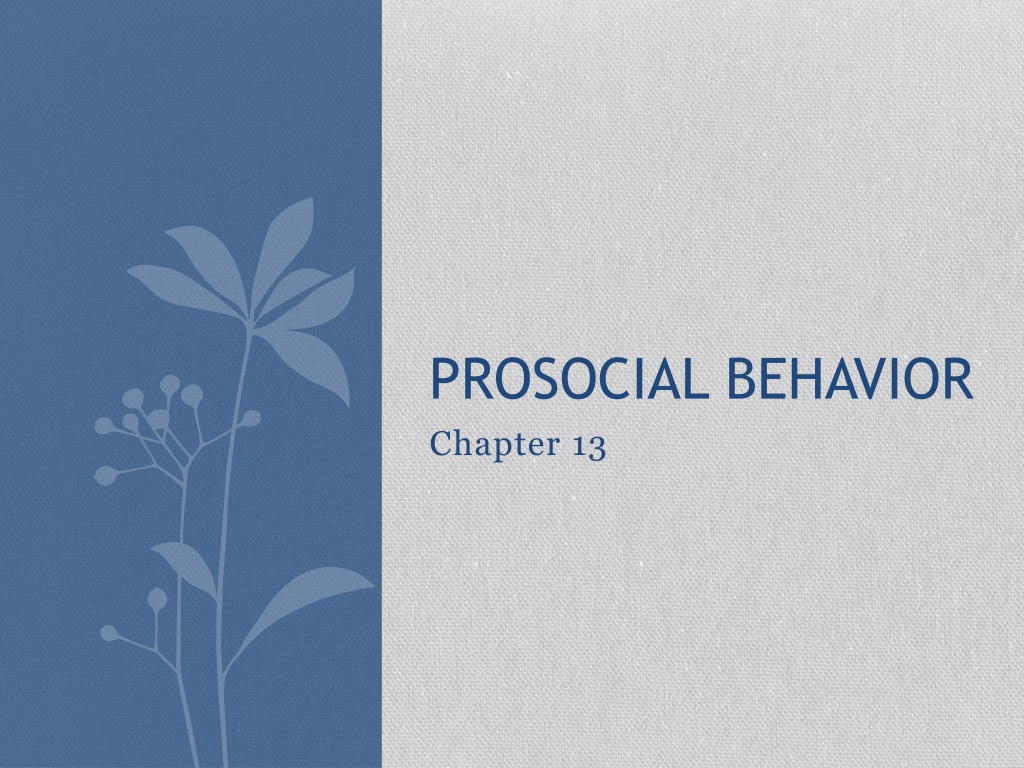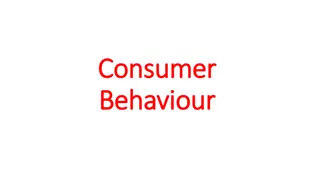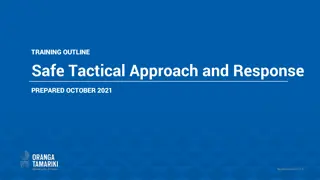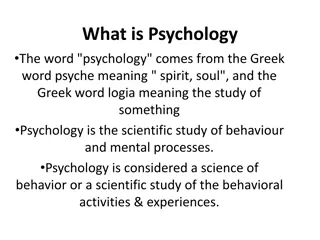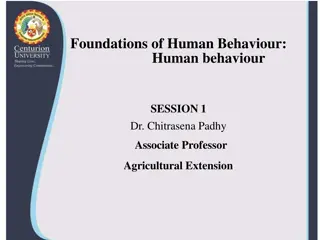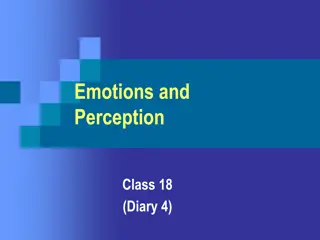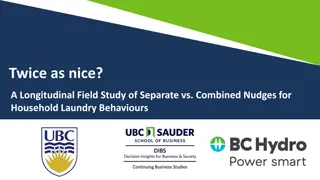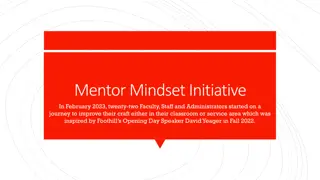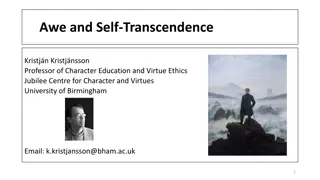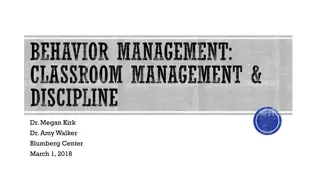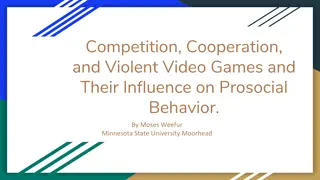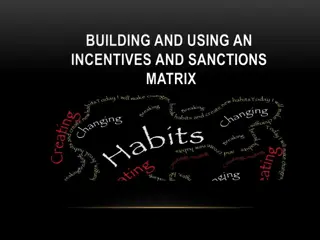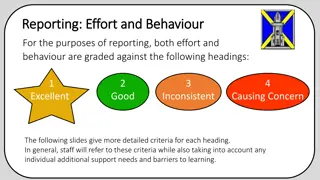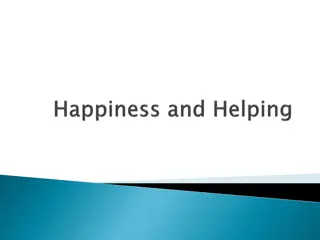Understanding Prosocial Behavior and Why People Choose to Help
Prosocial behavior, including altruism, involves acts that benefit others without expecting personal gain. People choose to help due to evolutionary psychology, social norms, social exchange theory, and the empathy-altruism hypothesis. Various factors like reciprocity, rewards, and empathy influence individuals' decisions to help, considering both benefits and costs involved.
Download Presentation

Please find below an Image/Link to download the presentation.
The content on the website is provided AS IS for your information and personal use only. It may not be sold, licensed, or shared on other websites without obtaining consent from the author. Download presentation by click this link. If you encounter any issues during the download, it is possible that the publisher has removed the file from their server.
E N D
Presentation Transcript
PROSOCIAL BEHAVIOR Chapter 13
What is Prosocial Behavior? Prosocial Behavior Any act performed with the goal of benefiting another person Altruism The desire to help another person even if it involves a cost to the helper and where there is not any expectation of personal gain
Why do people choose to help? Evolutionary Psychology Explanation The attempt to explain social behavior in terms of genetic factors that evolved over time according to the principles of natural selection. Any gene that furthers survival and increases the probability of producing offspring likely to be passed on Genes that lower chances of survival and reduce the chances of producing offspring less likely to be passed on
Why do people choose to help? SOCIAL NORMS Adaptive for individuals to learn social norms from other members of a society (Simon, 1990) Norm of Reciprocity The expectation that helping others will increase the likelihood that they will help us in the future.
Why do people choose to help? Social exchange theory In relationships with others, try to maximize the ratio of social rewards to social costs Helping can be rewarding in a number of ways: Increase likelihood of future help (reciprocity) Someone will help us when we need it Relief of another s distress Gain rewards Social approval Increased feelings of self-worth
Why do people choose to help? Potential Costs of Helping Physical danger Risk of experiencing pain Risk of embarrassment Time costs Social exchange theory argues that true altruism does not exist People help when the benefits outweigh the costs
Why do people choose to help? Empathy-Altruism Hypothesis The idea that when we feel empathy for a person, we will attempt to help that person purely for altruistic reasons, regardless of what we have to gain Empathy The ability to put oneself in the shoes of another person and to experience events and emotions (e.g., joy and sadness) the way that person experiences them (as if you were experiencing them yourself)
Summary of Theories on Motives for Helping Biological/Genetic (Evolutionary psychology) Learned Social Norms Social exchange theory Maximize rewards, minimize costs Empathy-altruism hypothesis Powerful feelings of empathy and compassion selfless giving
Helping & Personal Characteristics Personality Gender Group Membership Mood
Helping & Personal Characteristics Altruistic Personality: the qualities that cause an individual to help others in a wide variety of situations. Studies of both children and adults indicate that people with high scores on personality tests of altruism are not much more likely to help than those with lower scores.
Helping & Gender Consider two scenarios: In one, someone stops to change a tire for a stranded motorist or offers to fix a leaky faucet. In the other, someone is involved in a long-term helping relationship, such as assisting a disabled neighbor with chores around the house. Are men or women more likely to help in each situation? Men, in the first example and women in the second. While women are often believed to be more helpful than men, it seems to depend upon the type of help required and whether it is more associated with the male or female gender stereotype.
Helping & Group Membership People in all cultures are more likely to help anyone they define as a member of their in-group (the group with which an individual identifies as a member) than those they perceive in out-groups (any group with which an individual does not identify) When will we help in-group and out-group members? In-group: Help when we feel empathy Out-group: Help when it furthers own self-interests
Helping and Mood Feel good-Do good hypothesis When people are in a good mood, they are more helpful in a variety of ways! Results of a study testing this: 84% of people who found coins researcher left in mall pay phone helped a man pick up papers in one study. Only 4% of those who did not find coins helped.
Helping and Mood Feel good Do good Why? Being in a good mood can increase helping for these reasons: Good moods make us look on the bright side of life. Helping others can prolong our good mood. Good moods increase self-attention (Remember, that makes us compare ourselves to our own moral standards.)
Helping and Mood Feeling guilty clearly leads to an increase in helping, probably because people believe that good deeds cancel out bad deeds (penance). Sadness can also lead to an increase in helping, under some conditions. When sad, people are motivated to do things that make them feel better. Helping others lets them: Forget their own problems Feel useful and capable of solving a problem Compare their plight to someone else in trouble
Situational Determinants of Helping Number of people in the immediate environment Research using a man apparently in distress showed that in small towns, half the people who walked by stopped and offered to help. In large cities, only 15% of passersby stopped to help. When opportunity for helping arises, matters more whether the incident occurs in a rural or urban area than where the witnesses grew up.
People are less helpful in big cities than in small towns, not because of a difference in values, but because the stress of urban life causes them to keep to themselves. Source: (left): John Lund/Drew Kelly/Sam Diephuis/Glow Images, Inc.; (right): David Grossman/Alamy
Urban Overload Hypothesis People living in cities are constantly being bombarded with stimulation and they keep to themselves to avoid being overwhelmed by it. if you put urban dwellers in a calmer, less stimulating environment, they would be as likely as anyone else to reach out to others Research Supports the hypothesis
Residential Mobility It is not only where you live that matters, but how often you have moved from one place to another. People who have lived for a long time in one place more likely to engage in pro-social behaviors that help community. Living for a long time in one place leads to: Greater attachment to the community More inter-dependence with neighbors Greater concern with one's reputation in the community
The Bystander Effect Kitty Genovese's prolonged murder 38 witnesses failed to call police. Bibb Latan and John Darley (1970) considered why no one helped. The greater the number of bystanders who observe an emergency, the less likely any one is to help. This is known as the bystander effect.
Figure 11.4 Bystander Intervention Decision Tree: Five Steps to Helping in an Emergency Latan. and Darley (1970) showed that people go through five decision-making steps before they help someone in an emergency. If bystanders fail to take any one of the five steps, they will not help. Each step is outlined here, along with the possible reasons why people decide not to intervene. (Adapted from Latan. & Darley, 1970)
Bystander Effect Diffusion of Responsibility The phenomenon whereby each bystander s sense of responsibility to help decreases as the number of witnesses increases.
